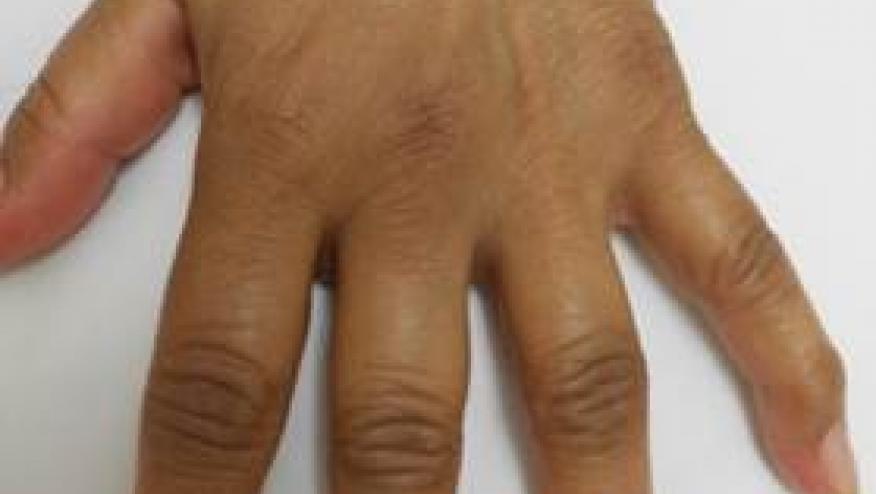PRAIRI Study - Can RA Be Prevented? Save

B-cell depletion may offer a means of delaying the onset of clinical arthritis in adults at high risk, according to the PRAIRI study - a proof-of-mechanism study in pre-clinical RA patients.
Among individuals who were seropositive, but had no evidence of rheumatoid arthritis (RA) at baseline and were given a single infusion of rituximab (Rituxan, MabThera) or placebo, there was a 12-month delay until the point where 25% of patients in both groups had developed arthritis (P<0.0001), according to Paul P. Tak, MD, PhD, of the Academic Medical Center in Amsterdam, and colleagues.
And, while the risk of developing arthritis with rituximab decreased by 55% at 12 months, this was not statistically significant (HR 0.45, 95% CI 0.15-1.32, P=0.15), the researchers reported online in Annals of the Rheumatic Diseases.
During the prodromal years-long phase of RA, many markers of autoimmunity appear, including immunoglobulin M rheumatoid factor (IgM-RF) and anti-citrullinated peptide antibodies (ACPA). An estimated 40% of individuals who are seropositive for both markers develop RA within 2 years. Other markers that are detected early include acute-phase reactants and proinflammatory cytokines and chemokines.
Clonal changes are also seen in peripheral B cells during the preclinical phase of the disease, even as the synovial tissue remains normal.
Tak and co-authors explained that because B cells have been implicated in the pathogenesis of RA through mechanisms including antigen presentation and T-cell activation, and the depletion of these cells with rituximab has demonstrated efficacy in patients with established disease, the team undertook a phase IIb randomized trial to explore the possibility of altering the course of disease through B cell depletion before clinical RA develops.
The team enrolled 81 patients who had arthralgia and were positive for IgM-RF and ACPA and had C-reactive protein (CRP) levels above 0.6 mg/L or subclinical synovitis detected on imaging, randomizing the participants to a single intravenous infusion of 1,000 mg of rituximab or placebo.
The majority of patients in the study were women, and mean age was 53. Baseline CRP concentration was 3 mg/L and erythrocyte sedimentation rate (ESR) was 10 mm/h.
During a median follow-up of 29 months, 40% of patients in the placebo group developed RA, at a median time of 11.5 months. In the rituximab group, 34% of patients developed RA after a median time of 16.5 months.
The researchers also conducted an exploratory analysis of biomarkers, and found associations with RA for baseline ESR (HR 1.03, 95% CI 1.01-1.06, P=0.016) and anti-citrullinated α-enolase peptide 1 (HR 3.71, 95% CI 1.51-9.18, P=0.01). Within 4 weeks of treatment, there was "a clear and highly significant" decline in B-cell numbers, followed by a decrease in levels of IgA-RF, IgM-RF, IgG-RF, and ACPA.
The treatment was generally well tolerated, with mild infusion reactions and no serious infections, Tak and co-authors reported, adding that all serious adverse events were considered unrelated to the treatment.
RA has a significant impact not only on the individual patient but also on society, as it is relatively common, disabling, and expensive to treat, the investigators stated. Early and aggressive treatment has been shown to greatly improve outcomes, confirming the existence of a "therapeutic window of opportunity."
"We are now capable of identifying individuals during an even earlier stage, when they are at risk of developing seropositive RA but before the onset of arthritis. This makes it possible to study where there is a 'preventive window of opportunity,'" Tak and colleagues wrote.
The observation that the single rituximab infusion did not fully prevent RA onset and merely delayed it may have resulted from the persistence of some B cells in tissues and subsequent repopulation. "It is tempting to speculate that repeated treatment, perhaps with a single infusion of rituximab once a year, might be sufficient to control B-cell numbers and prevent clinically manifest disease in a population at high risk of developing RA," the researchers said.
Additional approaches could include targeting the subpopulation of specific autoreactive B cells and proinflammatory innate immune cells.
"The results presented here are clearly consistent with the critical role of B cells in the pathogenesis of RA during the earliest stages of the disease and support future studies aimed at secondary prevention of RA, including by the use of targeted treatments," the investigators concluded.
A limitation of the study, they said, was the small sample size.
The study was funded by the Dutch Arthritis Foundation, the Netherlands Organization for Health Research and Development, the European Union Seventh Framework Program, and EU-funded project BeTheCure.
The authors reported financial relationships with GlaxoSmithKline, AbbVie, Janssen, Ergomed Clinical Research, Pfizer, Boehringer Ingelheim, Roche, Merck Sharp & Dohme, UCB, and AstraZeneca.










If you are a health practitioner, you may Login/Register to comment.
Due to the nature of these comment forums, only health practitioners are allowed to comment at this time.